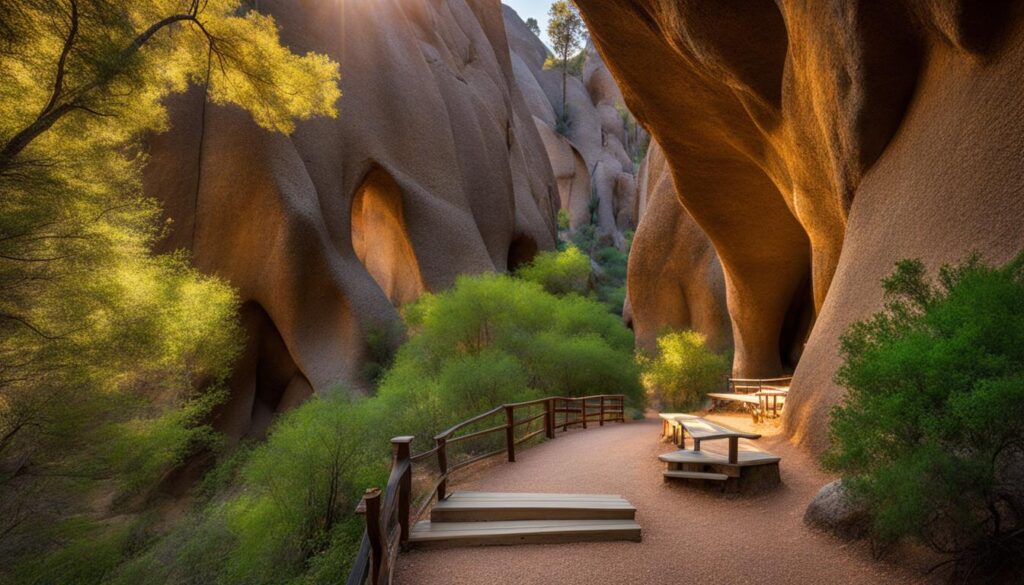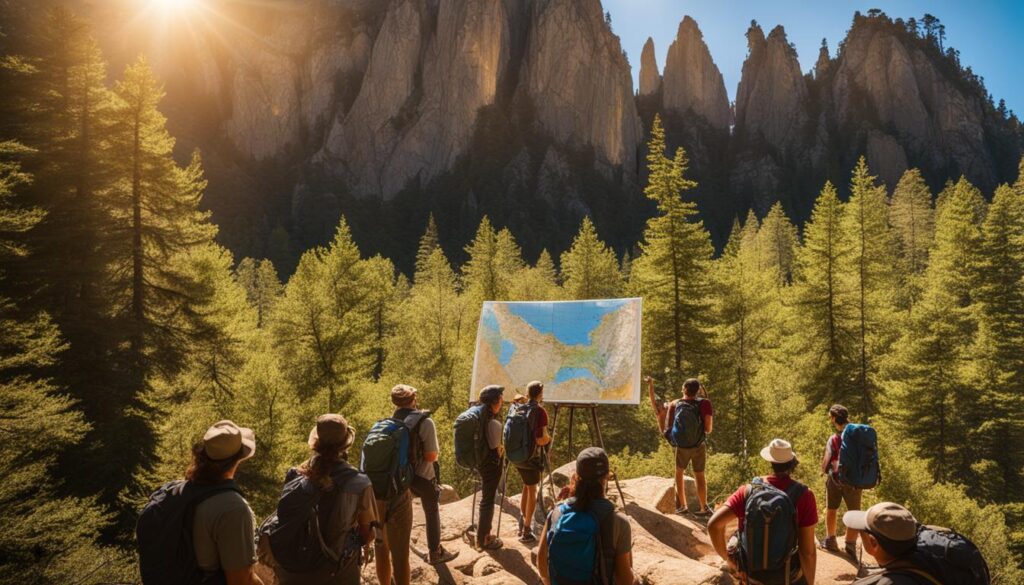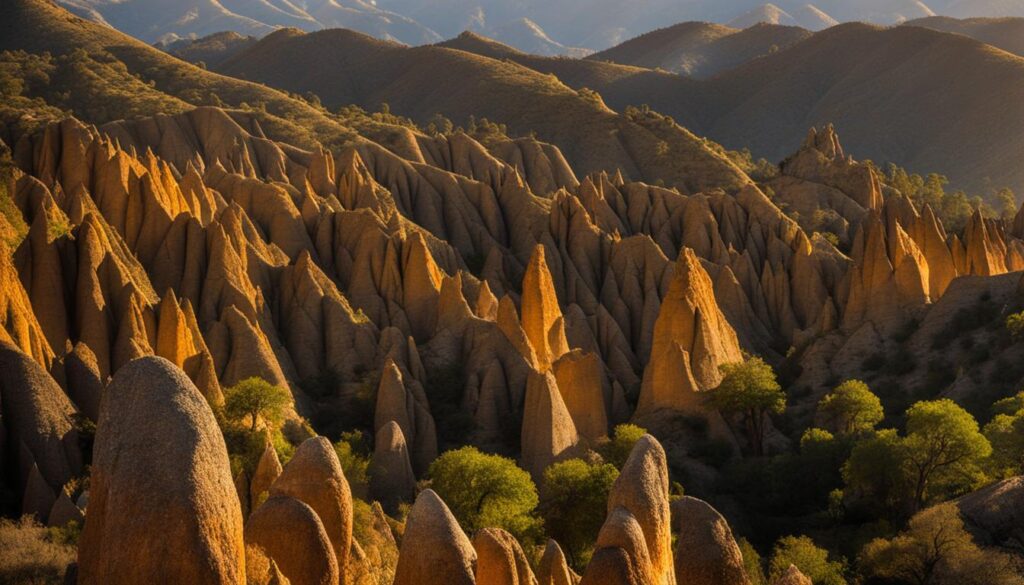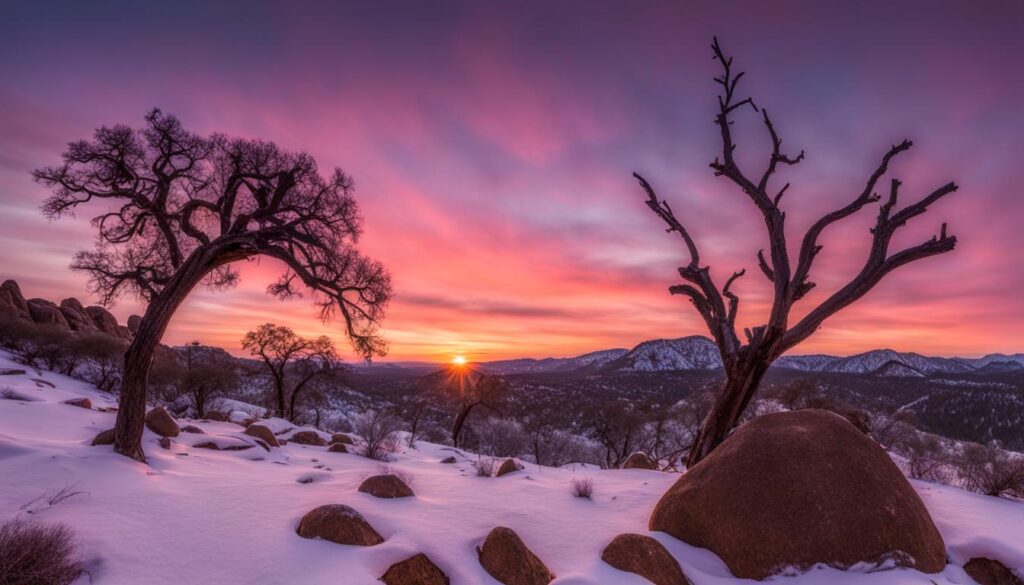Pinnacles National Park offers a unique experience for outdoor enthusiasts, with its diverse range of activities and stunning landscapes. But before you embark on your trip, it’s important to understand the weather conditions at Pinnacles National Park. The park has a Mediterranean climate, characterized by hot and dry summers, and mild winters with moderate precipitation. The seasonal temperatures can vary greatly, with daytime temperatures often exceeding 100°F in the summer and overnight subfreezing temperatures in the winter. Spring and fall are considered the most pleasant seasons for hiking and exploring the park. It’s crucial to check the current weather conditions and plan accordingly, especially during the extreme temperatures of summer. By being prepared and aware of the weather patterns at Pinnacles National Park, you can make the most of your visit and ensure a safe and enjoyable experience.
Key Takeaways:
- Pinnacles National Park has a Mediterranean climate with hot summers and mild winters.
- Summer temperatures can exceed 100°F, while winter temperatures can drop below freezing.
- Spring and fall are the most pleasant seasons for outdoor activities at the park.
- It’s important to check the current weather conditions and plan accordingly to ensure a safe and enjoyable visit.
- By understanding the weather patterns at Pinnacles National Park, you can make the most of your trip and optimize your outdoor activities.
Pinnacles National Park Weather: Current Conditions and Updates
To stay informed about the latest weather conditions at Pinnacles National Park, it’s recommended to check the official sources for current updates. The park provides alerts and information on their website, including any potential hazards or restrictions due to weather conditions. Checking these updates regularly will help you plan your activities accordingly and ensure your safety while exploring the park.
Additionally, the National Weather Service offers a forecast for the park, providing detailed information about temperature, precipitation, and other weather-related factors. By staying updated on the current weather conditions and forecasts, you can make the most of your visit to Pinnacles National Park.
Pinnacles Park Current Conditions: Today’s Weather
| Temperature | Wind Speed | Precipitation |
|---|---|---|
| 75°F | 10 mph | 0% |
Whether you’re planning a day hike, camping trip, or simply exploring the park’s stunning rock formations, being aware of the current weather conditions is essential. By knowing the temperature, wind speed, and likelihood of precipitation, you can dress appropriately, pack necessary gear, and adjust your activities accordingly. Stay informed, stay safe, and enjoy your time at Pinnacles National Park!
Pinnacles National Park Weather: Best Times to Visit
Pinnacles National Park offers different experiences depending on the time of year you visit. The best times to visit the park are during the spring and fall, when the weather is typically more moderate and pleasant for outdoor activities. In the spring, the grasses are green, and a variety of wildflowers can be seen along the trails, making it an ideal time for hiking. Fall is also a great time to visit, with pleasant temperatures and beautiful foliage. However, it’s important to note that Pinnacles National Park is most popular in the cooler months, as the extreme temperatures of summer can make hiking uncomfortable and potentially dangerous. To plan your visit, it’s recommended to check the weather forecast and choose a time when the weather conditions align with your preferred activities and comfort level.
Spring:
Spring is a wonderful time to visit Pinnacles National Park, as the park comes alive with vibrant colors and fresh growth. The mild temperatures, usually ranging from the 60s to the 80s, make it comfortable for outdoor activities such as hiking and wildlife observation. The trails are lined with blooming wildflowers, creating a picturesque setting for nature enthusiasts. It’s advisable to bring layers of clothing, as the weather can change throughout the day. Additionally, it’s important to check the park’s website for any potential closures or restrictions due to weather conditions or maintenance work.
Fall:
Fall brings cooler temperatures to Pinnacles National Park, with highs ranging from the 60s to the 80s. This season offers pleasant weather for hiking, camping, and exploring the park’s unique rock formations. The changing foliage adds a touch of autumnal beauty to the landscape, making it a favorite time for photographers and nature lovers. It’s recommended to bring a jacket or sweater, as temperatures can drop in the evenings. As with any visit to the park, it’s essential to check for any updates or closures before your trip.
| Season | Temperature Range | Main Attractions |
|---|---|---|
| Spring | 60s – 80s | Wildflowers, moderate temperatures |
| Fall | 60s – 80s | Changing foliage, moderate temperatures |
By choosing to visit during the best times for weather and activities, you can make the most of your experience at Pinnacles National Park. Whether you prefer the vibrant colors of spring or the cool temperatures of fall, planning your visit around the weather forecast ensures an enjoyable and comfortable trip. Take advantage of the park’s natural beauty and diverse landscapes during these ideal seasons for outdoor exploration.
Pinnacles National Park Weather: Hours and Operations
When planning your visit to Pinnacles National Park, it’s essential to be aware of the park’s hours of operation and any specific operational details. This information will help ensure that you can make the most of your time at the park and have a seamless experience. The park is generally open year-round, but it’s important to note that certain areas or facilities may have different operating hours or temporary closures at specific times. To stay informed, it is recommended to check the park’s official website or contact the visitor center directly for the most up-to-date information.
By being aware of the park’s hours and operations, you can plan your activities accordingly and avoid any potential disappointments. Whether you’re interested in exploring the hiking trails, visiting the visitor center, or participating in educational programs, it’s crucial to check the park’s schedule beforehand. This will allow you to allocate sufficient time for each activity and ensure that you don’t miss out on any opportunities. Additionally, it’s always a good idea to arrive early, especially during peak seasons, to secure parking and make the most of your visit.
| Visitor Center Hours | Day Use Hours | Camping Operations |
|---|---|---|
| Monday – Friday: 9:00 am – 4:30 pm | Day use areas open from sunrise to sunset | The campgrounds are open year-round |
| Saturday – Sunday: 8:00 am – 5:00 pm | Entrance gates open at 7:30 am and close at sunset | Reservations required for tent campsites |
It’s worth noting that during extreme weather conditions or emergencies, the park may have temporary closures or restrictions for visitor safety. Therefore, it’s advisable to check the park’s website or contact the visitor center before your visit, especially if there are any weather-related concerns. By staying informed about the park’s hours and operational updates, you can ensure a smooth and enjoyable experience at Pinnacles National Park.
Pinnacles National Park Weather: RV Parks and Camping
If you’re planning a visit to Pinnacles National Park, you have the option to stay overnight and fully immerse yourself in the park’s natural beauty by camping or parking your RV. The park offers both RV parks and traditional campsites, providing different experiences for visitors.
The RV park at Pinnacles National Park is located near the east entrance and offers amenities such as electrical hookups, water, and dump stations. It operates on a first-come, first-served basis, so it’s advisable to arrive early to secure a spot. The RV park is a convenient option for those who prefer the comfort of their own vehicles and the convenience of having necessary facilities nearby.
If you prefer traditional camping, Pinnacles National Park has two campgrounds with tent sites. These campgrounds offer a serene and immersive experience in nature, allowing you to fully enjoy the park’s surroundings. However, it’s important to note that reservations are required for the tent campsites, so be sure to plan ahead and make your reservations well in advance.
| Accommodation Type | Location | Amenities | Reservation Required |
|---|---|---|---|
| RV Park | Near the east entrance | Electrical hookups, water, dump stations | No |
| Tent Campsites | Two campgrounds within the park | Natural surroundings | Yes |
Both RV camping and tent camping are subject to weather conditions, so it’s advisable to check the current weather and plan accordingly. Be sure to pack necessary camping gear, including appropriate clothing and equipment, to ensure a comfortable and enjoyable camping experience at Pinnacles National Park.
Pinnacles National Park Weather: Hotels, Campsites, Cabins

If you prefer to stay in a hotel or cabin during your visit to Pinnacles National Park, there are options available in the surrounding areas. Nearby towns and cities offer a range of accommodations, including hotels, motels, and cabins. These options provide comfortable lodging and amenities for visitors who prefer a more traditional accommodation experience.
Additionally, the park has campsites available for those who prefer to camp in a tent or RV. These campsites offer a closer connection to nature and the park’s unique environment. It’s important to check availability and make reservations in advance, especially during peak seasons, to secure your preferred accommodation option.
When planning your stay at Pinnacles National Park, it’s helpful to consider the pros and cons of each type of accommodation. Hotels and cabins offer more convenience and comfort, with amenities such as private bathrooms and heating. On the other hand, camping allows you to immerse yourself fully in nature and experience the park’s beauty up close.
| Type | Pros | Cons |
|---|---|---|
| Hotels | Comfort and convenience | Higher cost |
| Cabins | Privacy and unique experience | Limited availability |
| Campsites | Close to nature, lower cost | Limited amenities |
No matter which option you choose, it’s important to plan ahead and make reservations in advance. This will ensure that you have a comfortable place to stay during your visit to Pinnacles National Park. Remember to check the current weather conditions and pack accordingly, as temperatures can vary throughout the year.
Quotes:
“I enjoyed staying at the cabin near Pinnacles National Park. It was a unique experience, and I felt like I was part of nature.” – Emily G.
“The hotels in the nearby town were very convenient for exploring the park. The staff was friendly and helpful, and the rooms were comfortable.” – Jason M.
Pinnacles National Park Weather: Planning Your Visit

When planning your visit to Pinnacles National Park, it’s important to consider various factors to ensure a memorable and enjoyable experience. Understanding the park’s weather conditions is crucial, as it can greatly impact your activities and overall comfort. By gathering information about the park’s hours, operations, and current weather conditions, you can make informed decisions and plan accordingly.
One important aspect to consider is the best time to visit the park. As mentioned in the previous sections, spring and fall are generally considered the most pleasant seasons for outdoor activities in Pinnacles National Park. These seasons offer milder temperatures and beautiful natural displays, such as blooming wildflowers and vibrant foliage. Planning your visit during these times can enhance your experience and provide optimal conditions for hiking, wildlife spotting, and exploring the park’s stunning landscapes.
Another aspect to keep in mind is the specific activities you want to engage in during your visit. Pinnacles National Park offers a wide range of activities, including hiking, camping, wildlife viewing, and rock climbing. Each activity may have different requirements or considerations when it comes to weather conditions. For example, if you plan to go hiking, it’s essential to check the weather forecast and plan your hike accordingly to avoid extreme heat or potentially hazardous conditions. By tailoring your visit to your preferred activities and aligning them with the weather conditions, you can optimize your time at Pinnacles National Park.
Lastly, ensure you are well-prepared for the weather conditions you may encounter during your visit. This includes dressing appropriately, bringing adequate sun protection, and staying hydrated. It’s also advisable to check the park’s official website or contact the visitor center for any additional guidelines or recommendations related to weather conditions. By being prepared, you can make the most of your trip and fully enjoy the natural wonders of Pinnacles National Park.
Table: Activities and Recommended Weather Conditions
| Activity | Recommended Weather Conditions |
|---|---|
| Hiking | Moderate temperatures, clear skies |
| Camping | Mild temperatures, minimal precipitation |
| Wildlife Viewing | Mild temperatures, quiet weather |
| Rock Climbing | Moderate temperatures, dry conditions |
By considering the factors mentioned above and utilizing the available resources, such as weather forecasts and park updates, you can plan your visit to Pinnacles National Park with confidence. The park offers a breathtaking and diverse natural environment, and proper planning will allow you to make the most of your time and create unforgettable memories.
Pinnacles National Park Weather: Directions
Getting to Pinnacles National Park is an exciting part of the journey, as it takes you through scenic routes and beautiful landscapes. Whether you’re coming from San Francisco or Southern California, there are a few different ways to reach the park.
From San Francisco or the Bay Area:
If you’re starting your journey from San Francisco or the Bay Area, the most common route is to take Highway 101 south and then connect to Highway 25. This will lead you directly to the park’s east entrance. Along the way, you’ll be treated to breathtaking views of the California countryside and rolling hills.
From Los Angeles or Southern California:
For those traveling from Los Angeles or Southern California, the best route is to take Highway 101 north and then connect to Highway 146. This will bring you to the park’s west entrance. As you drive through the picturesque landscapes of Central California, you’ll have the opportunity to soak in the natural beauty of the region.
To ensure you find your way easily, it’s always a good idea to use GPS or maps for accurate directions based on your specific starting point. With the right guidance, you’ll be able to navigate the roads with ease and arrive at Pinnacles National Park ready to embark on your adventure.
| Starting Point | Route |
|---|---|
| San Francisco or Bay Area | Highway 101 South, then connect to Highway 25 |
| Los Angeles or Southern California | Highway 101 North, then connect to Highway 146 |
Whichever route you choose, the journey to Pinnacles National Park promises to be as magnificent as the destination itself. So sit back, relax, and enjoy the drive as you make your way to this extraordinary natural wonder.
Pinnacles National Park Weather: History

Pinnacles National Park has a rich and captivating history that spans millions of years. The park’s unique rock formations, known as the pinnacles, are the result of tectonic activity along the San Andreas Fault. Over time, the movement of the Pacific Plate and the North American plate has caused the uplift and erosion of the landscape, creating the striking and rugged terrain that visitors see today.
The formation of Pinnacles National Park began around 23 million years ago when volcanic eruptions covered the region with layers of ash and lava. As the Earth’s crust shifted, the rocks were fractured and uplifted, exposing them to the forces of erosion. The combination of erosion and weathering gradually sculpted the landscape into the iconic pinnacles that dot the park.
“The unique geology of Pinnacles National Park tells a story of dynamic geological processes that have shaped the landscape over millions of years.”
Exploring the park’s geology not only offers a glimpse into the Earth’s history but also provides opportunities for scientific research and education. The park’s location, several miles inland from the ocean, has allowed for the preservation of diverse ecosystems and habitats. Pinnacles National Park was established as a national monument in 1908 and later designated as a national park in 2013, ensuring the protection and preservation of its natural and historical significance.
Table: Geological Timeline of Pinnacles National Park
| Period | Geological Event |
|---|---|
| 23 million years ago | Volcanic eruptions deposit layers of ash and lava |
| 5 million years ago | Continued volcanic activity and uplift along the San Andreas Fault |
| 1 million years ago | Glaciation and erosion shape the landscape |
| 1908 | Pinnacles National Monument established |
| 2013 | Pinnacles National Park designated |
The geological timeline of Pinnacles National Park highlights the complex and transformative processes that have shaped the park’s unique features. From volcanic activity to tectonic shifts, the forces of nature have created an awe-inspiring landscape that attracts visitors from around the world.
Pinnacles National Park Weather: Nearby Towns
Pinnacles National Park is surrounded by several towns and cities that offer additional attractions and amenities for visitors. These nearby towns provide opportunities for exploration and relaxation, allowing you to extend your trip beyond the boundaries of the park. Some of the most popular towns near Pinnacles National Park include:
- Monterey: Known for its beautiful coastline and vibrant art scene, Monterey offers stunning views of the ocean, charming shops, and delicious seafood restaurants.
- Salinas: Located in the heart of the Salinas Valley, Salinas is famous for its agricultural heritage and is the birthplace of renowned author John Steinbeck. Visitors can explore the Steinbeck House and enjoy the town’s cultural events and festivals.
- Gilroy: Known as the Garlic Capital of the World, Gilroy offers a unique shopping and dining experience. Visitors can enjoy the town’s annual Garlic Festival and explore its charming downtown area.
These nearby towns offer a variety of attractions, accommodations, and dining options for visitors to Pinnacles National Park. Whether you’re looking to relax on the coast, immerse yourself in art and culture, or indulge in delicious cuisine, these towns provide the perfect complement to your park experience.
| Town | Attractions | Distance from Pinnacles National Park |
|---|---|---|
| Monterey | Beautiful coastline, art scene, seafood restaurants | Approximately 60 miles |
| Salinas | Steinbeck House, cultural events, festivals | Approximately 17 miles |
| Gilroy | Garlic Festival, shopping, dining | Approximately 35 miles |
Whether you’re looking to explore the stunning coastline, immerse yourself in art and culture, or indulge in delicious cuisine, the nearby towns to Pinnacles National Park offer a variety of experiences for visitors. Consider extending your trip and exploring these towns to enhance your overall adventure at Pinnacles National Park.
Pinnacles National Park Weather: Winter vs Summer

When planning a trip to Pinnacles National Park, it’s important to consider the weather conditions during the winter and summer seasons. The park experiences distinct weather patterns that can greatly impact your visit. The winter season brings milder temperatures and moderate precipitation, making it an ideal time for hiking and exploring the park’s trails. The cooler temperatures offer a comfortable environment for outdoor activities and provide an opportunity to witness the park’s unique winter landscapes.
On the other hand, summer in Pinnacles National Park brings extreme temperatures, often exceeding 100°F. These hot conditions can make hiking uncomfortable and potentially dangerous, especially for those who are not adequately prepared. It’s crucial to take precautions, such as hydrating properly and avoiding the hottest parts of the day, if visiting during the summer months. By understanding the weather differences between winter and summer, you can choose the best time to visit based on your preferences and comfort level.
In summary, the winter season at Pinnacles National Park offers milder temperatures and moderate precipitation, making it a great time for outdoor activities. The summer season, on the other hand, brings extreme heat and requires extra caution to ensure a safe visit. By considering the weather conditions and planning your trip accordingly, you can make the most of your time at Pinnacles National Park.
Conclusion
As I conclude this Pinnacles National Park weather guide, it’s evident that understanding the park’s weather conditions is crucial for successful trip planning. By taking into account the park’s Mediterranean climate, extreme temperatures, and seasonal variations, you can make informed decisions about when to visit and what activities to engage in.
Remember to check the current weather conditions and updates from official sources before heading to the park. Staying informed will help you plan your activities accordingly and ensure your safety while exploring Pinnacles National Park.
Whether you’re interested in hiking, camping, or simply admiring the park’s natural beauty, the weather at Pinnacles National Park will undoubtedly influence your experience. By considering the best times to visit, checking hours of operation, and being prepared for the specific weather conditions, you can optimize your trip and create lasting memories at Pinnacles National Park.
So, start your trip planning journey now, armed with the knowledge about Pinnacles National Park weather. Whether you’re a seasoned outdoor enthusiast or a first-time visitor, the unique landscapes and weather patterns at Pinnacles National Park promise an adventure like no other.
FAQ
What is the weather like at Pinnacles National Park?
Pinnacles National Park has a Mediterranean climate, with hot and dry summers and mild winters with moderate precipitation.
When is the best time to visit Pinnacles National Park?
The spring and fall are considered the most pleasant seasons for hiking and exploring the park.
What are the hours of operation at Pinnacles National Park?
The park is generally open year-round, but certain areas and facilities may have different operating hours or closures at specific times.
Is there camping available at Pinnacles National Park?
Yes, Pinnacles National Park offers options for RV camping and traditional camping with tent sites.
Are there hotels or cabins near Pinnacles National Park?
Yes, there are hotels, motels, cabins, and campsites available in the surrounding areas of Pinnacles National Park.
How do I plan my visit to Pinnacles National Park?
It’s important to consider factors such as weather conditions, park hours, activities, and reservations when planning your visit to Pinnacles National Park.
How do I get to Pinnacles National Park?
Pinnacles National Park is located in central California, approximately 125 miles south of San Francisco and west of the Big Sur coastline.
What is the history of Pinnacles National Park?
Pinnacles National Park’s unique rock formations were formed millions of years ago as a result of the San Andreas Fault and geological shifts.
What are the nearby towns and cities near Pinnacles National Park?
Monterey, Salinas, and Gilroy are popular destinations near Pinnacles National Park.
How does the weather differ between winter and summer at Pinnacles National Park?
Winter brings milder temperatures and moderate precipitation, while summer brings extreme temperatures exceeding 100°F.

